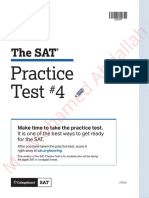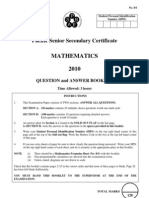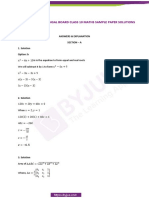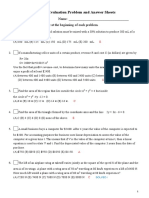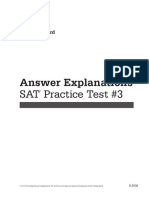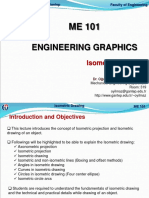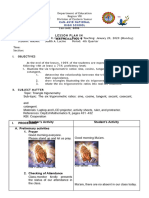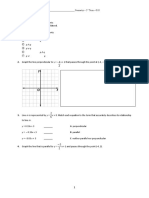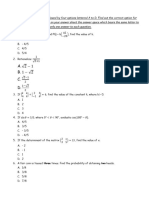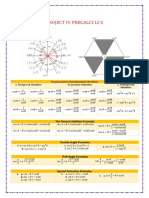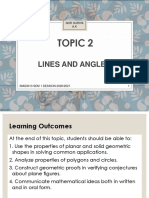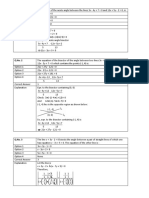614 Math Answer Key
Uploaded by
lewisondieki53614 Math Answer Key
Uploaded by
lewisondieki53SAT ANSWER EXPLANATIONS n MATH: MODULE 1
Math
Module 1
(27 questions)
QUESTION 1
Choice A is correct. Subtracting 8 from both sides of the given equation yields
p + 3 = 2. Subtracting 3 from both sides of this equation yields p =-1.
Choice B is incorrect and may result from conceptual or calculation errors.
Choice C is incorrect and may result from conceptual or calculation errors.
Choice D is incorrect and may result from conceptual or calculation errors.
QUESTION 2
Choice D is correct. An appropriate model should follow the trend of the data
points and should have data points both above and below the model. The
scatterplot shows that the data points have an increasing trend that is curved.
Therefore, an appropriate model should be an increasing curve with data points
both above and below the model. Of the given choices, only the model in choice D
is an increasing curve with data points both above and below the model.
Choice A is incorrect. Since the trend of the data points isn’t linear, a line isn’t the
most appropriate model for the data. Choice B is incorrect. Since the trend of the
data points is increasing and isn’t linear, a decreasing line isn’t the most
appropriate model for the data. Choice C is incorrect. All the data points are below
the model shown in this graph.
QUESTION 3
Choice D is correct. Adding 53 to each side of the given equation yields k 2 = 144.
Taking the square root of each side of this equation yields k =!12. Therefore, the
positive solution to the given equation is 12.
Choice A is incorrect. This is the positive solution to the equation
k 2 - 53 = 20,683, not k 2 - 53 = 91. Choice B is incorrect. This is the positive
solution to the equation k 2 - 53 = 5,131, not k 2 - 53 = 91. Choice C is incorrect.
This is the positive solution to the equation k 2 - 53 = 1,391, not k 2 - 53 = 91.
34 SAT PRACTICE TEST #6 ANSWER EXPLANATIONS
SAT ANSWER EXPLANATIONS n MATH: MODULE 1
QUESTION 4
Choice D is correct. It’s given that during a portion of a flight, a small airplane’s
cruising speed varied between 150 miles per hour and 170 miles per hour. It’s
also given that s represents the cruising speed, in miles per hour, during this
portion of the flight. It follows that the airplane’s cruising speed, in miles per hour,
was at least 150, which means s $ 150, and was at most 170, which means
s # 170. Therefore, the inequality that best represents this situation is
150 # s # 170.
Choice A is incorrect and may result from conceptual or calculation errors.
Choice B is incorrect and may result from conceptual or calculation errors.
Choice C is incorrect and may result from conceptual or calculation errors.
QUESTION 5
Choice A is correct. It’s given that the variable y represents the height, in meters,
of the object above the ground. The graph shows that the height of the object
was increasing from x = 0 to x = 2, and decreasing from x = 2 to x = 4. Therefore,
the height of the object was increasing for the entire interval of time from x = 0 to
x = 2.
Choice B is incorrect. The height of the object wasn’t increasing for this entire
interval of time, as it was decreasing from x = 2 to x = 4. Choice C is incorrect.
The height of the object was decreasing, not increasing, for this entire interval of
time. Choice D is incorrect. The height of the object was decreasing, not
increasing, for this entire interval of time.
QUESTION 6
The correct answer is 31. It’s given that 1 yard is equal to 36 inches. Therefore,
1,116 inches is equivalent to `1,116 inchesjc 36 inches m, or 31 yards.
1 yard
QUESTION 7
The correct answer is 11. It’s given that the function f ^xh= 14 + 4x represents the
total cost, in dollars, of attending an arcade when x games are played.
Substituting 58 for f ^xh in the given equation yields 58 = 14 + 4x . Subtracting 14
from each side of this equation yields 44 = 4x . Dividing each side of this equation
by 4 yields 11= x . Therefore, 11 games can be played for a total cost of $58.
QUESTION 8
Choice D is correct. It’s given that when x = 0, f ^xh= 30. Substituting 0 for x and
30 for f ^xh in the given function yields 30 = 0 + b, or 30= b. Therefore, the value
of b is 30.
Choice A is incorrect and may result from conceptual or calculation errors.
Choice B is incorrect and may result from conceptual or calculation errors.
Choice C is incorrect and may result from conceptual or calculation errors.
35 SAT PRACTICE TEST #6 ANSWER EXPLANATIONS
SAT ANSWER EXPLANATIONS n MATH: MODULE 1
QUESTION 9
Choice B is correct. The function P gives the estimated number of marine
mammals in a certain area, where t is the number of years since a study began.
Since the value of P ^0h is the value of P ^t h when t = 0, it follows that P ^0h= 1,800
means that the value of P ^t h is 1,800 when t = 0. Since t is the number of years
since the study began, it follows that t = 0 is 0 years since the study began, or
when the study began. Therefore, the best interpretation of P ^0h= 1,800 in this
context is the estimated number of marine mammals in the area was 1,800 when
the study began.
Choice A is incorrect and may result from conceptual or calculation errors.
Choice C is incorrect and may result from conceptual or calculation errors.
Choice D is incorrect and may result from conceptual or calculation errors.
QUESTION 10
Choice B is correct. It’s given that the shop’s inventory starts with 4,500 paper
cups and that the manager estimates that 70 of these paper cups are used each
day. Let x represent the number of days in which the estimated supply of paper
cups will reach 1,700. The equation 4,500 - 70x = 1,700 represents this situation.
Subtracting 4,500 from both sides of this equation yields -70x =-2,800.
Dividing both sides of this equation by -70 yields x = 40. Therefore, based on
this estimate, the supply of paper cups will reach 1,700 in 40 days.
Choice A is incorrect. After 20 days, the estimated supply of paper cups would be
4,500 - 70 ^20h, or 3,100 cups, not 1,700 cups. Choice C is incorrect. After 60
days, the estimated supply of paper cups would be 4,500 - 70 ^60h, or 300 cups,
not 1,700 cups. Choice D is incorrect. After 80 days, the estimated supply of
paper cups would be 4,500 - 70 ^80h, or -1,100 cups, which isn’t possible.
QUESTION 11
Choice A is correct. In each choice, the values of x are 2, 4, and 6. Substituting
the first value of x, 2, for x in the given inequality yields y 2 4 ^2h+ 8, or y 2 16.
Therefore, when x = 2, the corresponding value of y must be greater than 16. Of
the given choices, only choice A is a table where the value of y corresponding to
x = 2 is greater than 16. To confirm that the other values of x in this table and
their corresponding values of y are also solutions to the given inequality, the
values of x and y in the table can be substituted for x and y in the given
inequality. Substituting 4 for x and 30 for y in the given inequality yields
30 2 4 ^4h+ 8, or 30 2 24, which is true. Substituting 6 for x and 41 for y in the
given inequality yields 41 2 4 ^6h+ 8, or 41 2 32, which is true. It follows that for
choice A, all the values of x and their corresponding values of y are solutions to
the given inequality.
Choice B is incorrect. Substituting 2 for x and 8 for y in the given inequality
yields 8 2 4 ^2h+ 8, or 8 2 16, which is false. Choice C is incorrect. Substituting 2
for x and 13 for y in the given inequality yields 13 2 4 ^2h+ 8, or 13 2 16, which is
false. Choice D is incorrect. Substituting 2 for x and 13 for y in the given
inequality yields 13 2 4 ^2h+ 8, or 13 2 16, which is false.
36 SAT PRACTICE TEST #6 ANSWER EXPLANATIONS
SAT ANSWER EXPLANATIONS n MATH: MODULE 1
QUESTION 12
Choice B is correct. The expression ^x 2 + 11h2 can be written as
^x 2 + 11h^x 2 + 11h, which is equivalent to x 2 ^x 2 + 11h+11 ^x 2 + 11h . Distributing x 2
and 11 to ^x 2 + 11h yields x 4 + 11x 2 + 11x 2 + 121, or x 4 + 22x 2 + 121. The
expression ^x - 5h^x + 5h is equivalent to ^x - 5h x +^x - 5h 5 . Distributing x and 5
to ^x - 5h yields x 2 - 5x + 5x - 25, or x 2 - 25. Therefore, the expression
^x 2 + 11h2 +^x - 5h^x + 5h is equivalent to ^x 4 + 22x 2 + 121h+^x 2 - 25h , or
x 4 + 22x 2 + 121 + x 2 - 25. Combining like terms in this expression yields
x 4 + 23x 2 + 96.
Choice A is incorrect. Equivalent expressions must be equivalent for any value of
x. Substituting 0 for x in this expression yields -14, whereas substituting 0 for
x in the given expression yields 96. Choice C is incorrect. Equivalent expressions
must be equivalent for any value of x. Substituting 0 for x in this expression
yields 121, whereas substituting 0 for x in the given expression yields 96.
Choice D is incorrect. Equivalent expressions must be equivalent for any value of
x. Substituting 0 for x in this expression yields 146, whereas substituting 0 for x
in the given expression yields 96.
QUESTION 13
The correct answer is 12 . The value of h ^2h is the value of h ^xh when x = 2.
Substituting 2 for x in the given equation yields h ^2h= 5^28h+ 6 , which is equivalent
to h ^2h= 16
8
, or h ^2h= 12 . Therefore, the value of h ^2h is 12 . Note that 1/2 and .5 are
examples of ways to enter a correct answer.
QUESTION 14
The correct answer is 15
2
. The area, A, of a triangle is given by the formula
A = 12 bh, where b is the length of the base of the triangle and h is the height of
the triangle. In the right triangle shown, the length of the base of the triangle is
5 inches, and the height is 3 inches. It follows that b = 5 and h = 3. Substituting 5
for b and 3 for h in the formula A = 12 bh yields A = 12 ^5h^3h, which is equivalent to
A = 12 ^15h, or A = 15
2
. Therefore, the area of the triangle, in square inches, is 15
2
.
Note that 15/2 and 7.5 are examples of ways to enter a correct answer.
QUESTION 15
Choice B is correct. It’s given that the graph models the number of active projects
a company was working on x months after the end of November 2012. Therefore,
the value of x that corresponds to the end of November 2012 is 0. The point at
which x = 0 is the y-intercept of the graph. It follows that the y-intercept of the
graph shown is the point ^0, 5h. Therefore, according to the model, the predicted
number of active projects the company was working on at the end of November
2012 is 5.
37 SAT PRACTICE TEST #6 ANSWER EXPLANATIONS
SAT ANSWER EXPLANATIONS n MATH: MODULE 1
Choice A is incorrect. This is the value of x that corresponds to the end of
November 2012, not the predicted number of active projects the company was
working on at the end of November 2012. Choice C is incorrect. This is the
predicted number of active projects the company was working on 2 months after
the end of November 2012. Choice D is incorrect. This is the predicted number of
active projects the company was working on 4 months after the end of November
2012.
QUESTION 16
Choice C is correct. It’s given that the relationship between x and y is linear. An
equation representing a linear relationship can be written in the form y = mx + b,
where m is the slope and b is the y-coordinate of the y-intercept of the graph of
the relationship in the xy-plane. It’s given that for every increase in the value of x
by 1, the value of y increases by 8. The slope of a line can be expressed as the
change in y over the change in x. Thus, the slope, m, of the line representing this
relationship can be expressed as 81 , or 8. Substituting 8 for m in the equation
y = mx + b yields y = 8x + b. It’s also given that when the value of x is 2, the value
of y is 18. Substituting 2 for x and 18 for y in the equation y = 8x + b yields
18 = 8 ^2h+ b, or 18 = 16 + b. Subtracting 16 from each side of this equation
yields 2= b. Substituting 2 for b in the equation y = 8x + b yields y = 8x + 2.
Therefore, the equation y = 8x + 2 represents this relationship.
Choice A is incorrect. This equation represents a relationship where for every
increase in the value of x by 1, the value of y increases by 2, not 8, and when the
value of x is 2, the value of y is 22, not 18. Choice B is incorrect. This equation
represents a relationship where for every increase in the value of x by 1, the value
of y increases by 2, not 8, and when the value of x is 2, the value of y is 12, not
18. Choice D is incorrect. This equation represents a relationship where for every
increase in the value of x by 1, the value of y increases by 3, not 8, and when the
value of x is 2, the value of y is 32, not 18.
QUESTION 17
Choice D is correct. It’s given that the values of P, N, and C are positive.
P
Therefore, dividing each side of the given equation by N yields N
= 19 - C .
P
Subtracting 19 from each side of this equation yields N
- 19 =-C . Dividing each
side of this equation by -1 yields 19 - NP = C , or C = 19 - NP .
Choice A is incorrect. This equation is equivalent to P = NC - 19, not
P = N ^19 - Ch. Choice B is incorrect. This equation is equivalent to P = 19 - NC ,
not P = N ^19 - Ch. Choice C is incorrect. This equation is equivalent to
P = N ^C - 19h, not P = N ^19 - Ch.
38 SAT PRACTICE TEST #6 ANSWER EXPLANATIONS
SAT ANSWER EXPLANATIONS n MATH: MODULE 1
QUESTION 18
Choice D is correct. Adding 40 to both sides of the given equation yields
w 2 + 12w = 40. To complete the square, adding b 12 l , or 6 , to both sides of this
2
2
2
equation yields w 2 + 12w + 6 2 = 40 + 6 2 , or ^w + 6h2 = 76. Taking the square root of
both sides of this equation yields w + 6 =! 76 , or w + 6 =!2 19 . Subtracting
6 from both sides of this equation yields w =-6 ! 2 19 . Therefore, the solutions
to the given equation are -6 + 2 19 and -6 - 2 19 . Of these two solutions,
only -6 + 2 19 is given as a choice.
Choice A is incorrect and may result from conceptual or calculation errors.
Choice B is incorrect and may result from conceptual or calculation errors.
Choice C is incorrect and may result from conceptual or calculation errors.
QUESTION 19
Choice D is correct. If a data set contains an odd number of data values, the
median is represented by the middle data value in the list when the data values are
listed in ascending or descending order. Since the numbers of employees are
given as ranges of values rather than specific values, it’s only possible to
determine the range in which the median falls, rather than the exact median. Since
there are 17 restaurants included in the data set and the numbers of employees
are listed in ascending order, it follows that the median number of employees will
be represented by the ninth restaurant in the list. Since the first 2 restaurants
each have 2 to 7 employees, numbers of employees in the 2 to 7 range would be
represented by the first and second restaurants in the list. The next 4 restaurants
each have 8 to 13 employees. Therefore, numbers of employees in the 8 to 13
range will be represented by the third through sixth restaurants in the list. The
next 2 restaurants each have 14 to 19 employees. Therefore, numbers of
employees in the 14 to 19 range will be represented by the seventh and eighth
restaurants in the list. Since the next 7 restaurants each have 20 to 25
employees, numbers of employees in the 20 to 25 range will be represented by
the ninth through fifteenth restaurants in the list. This means that the ninth
restaurant in the list, which has the median number of employees for the
restaurants in this town, has a number of employees in the 20 to 25 range. Of the
given choices, the only number of employees in the 20 to 25 range is 21.
Choice A is incorrect and may result from conceptual or calculation errors.
Choice B is incorrect. This is the position of the median in the list, not the value of
the median. Choice C is incorrect and may result from conceptual or calculation
errors.
39 SAT PRACTICE TEST #6 ANSWER EXPLANATIONS
SAT ANSWER EXPLANATIONS n MATH: MODULE 1
QUESTION 20
The correct answer is 189
5
. A y-intercept of a graph in the xy-plane is a point where
the graph intersects the y-axis, which is a point with an x-coordinate of 0.
3^0h 5y 5y
Substituting 0 for x in the given equation yields 7
=- 9 + 21, or 0 =- 9 + 21.
5y
Subtracting 21 from both sides of this equation yields -21 =- 9 . Multiplying
both sides of this equation by -9 yields 189 = 5y . Dividing both sides of this
equation by 5 yields 189
5
= y . Therefore, the y-coordinate of the y-intercept of the
graph of the given equation in the xy-plane is 189
5
. Note that 189/5 and 37.8 are
examples of ways to enter a correct answer.
QUESTION 21
The correct answer is -24. Since the graph passes through the point ^0, - 6h, it
follows that when the value of x is 0, the value of y is -6. Substituting 0 for x
and -6 for y in the given equation yields -6 = 2 ^0h2 + b ^0h+ c, or -6 = c.
Therefore, the value of c is -6. Substituting -6 for c in the given equation yields
y = 2x 2 + bx - 6. Since the graph passes through the point ^-1, - 8h, it follows
that when the value of x is -1, the value of y is -8. Substituting -1 for x and
-8 for y in the equation y = 2x 2 + bx - 6 yields -8 = 2 ^-1h2 + b ^-1h- 6, or
-8 = 2 - b - 6, which is equivalent to -8 =-4 - b. Adding 4 to each side of this
equation yields -4 =-b. Dividing each side of this equation by -1 yields 4= b.
Since the value of b is 4 and the value of c is -6, it follows that the value of bc is
^4h^-6h, or -24.
Alternate approach: The given equation represents a parabola in the xy-plane with
a vertex at ^-1, - 8h. Therefore, the given equation, y = 2x 2 + bx + c, which is
written in standard form, can be written in vertex form, y = a ^x - hh2 + k , where
^h, kh is the vertex of the parabola and a is the value of the coefficient on the x 2
term when the equation is written in standard form. It follows that a = 2.
Substituting 2 for a, -1 for h, and -8 for k in this equation yields
y = 2 ^x - ^-1hh2 + ^-8h, or y = 2 ^x + 1h2 - 8. Squaring the binomial on the
right-hand side of this equation yields y = 2 ^x 2 + 2x + 1h- 8. Multiplying each term
inside the parentheses on the right-hand side of this equation by 2 yields
y = 2x 2 + 4x + 2 - 8, which is equivalent to y = 2x 2 + 4x - 6. From the given
equation y = 2x 2 + bx + c, it follows that the value of b is 4 and the value of c is
-6. Therefore, the value of bc is ^4h^-6h, or -24.
QUESTION 22
Choice D is correct. It’s given that in 2008 Zinah earned 14% more than in 2007.
Let h represent the amount Zinah earned in 2007 and let j represent the amount
that Zinah earned in 2008. This situation can be represented by the equation
j =b1 + 100
14
l h, or j = 1.14h. It’s also given that in 2009 Zinah earned 4% more
than in 2008. Let k represent the amount Zinah earned in 2009. This situation can
be represented by the equation k =b1 + 100
4
l j , or k = 1.04j . Substituting 1.14h for
j in the equation k = 1.04j yields k =^1.04h^1.14hh, or k = 1.1856h. If Zinah
earned y times as much in 2009 as in 2007, then the value of y is 1.1856.
40 SAT PRACTICE TEST #6 ANSWER EXPLANATIONS
SAT ANSWER EXPLANATIONS n MATH: MODULE 1
Choice A is incorrect and may result from conceptual or calculation errors.
Choice B is incorrect and may result from conceptual or calculation errors.
Choice C is incorrect and may result from conceptual or calculation errors.
QUESTION 23
Choice A is correct. According to the graph, the center of circle A has coordinates
^-2, 0h, and the radius of circle A is 3. It’s given that circle B is the result of
shifting circle A down 6 units and increasing the radius so that the radius of
circle B is 2 times the radius of circle A. It follows that the center of circle B is
6 units below the center of circle A. The point that’s 6 units below ^-2, 0h has the
same x-coordinate as ^-2, 0h and has a y-coordinate that is 6 less than the
y-coordinate of ^-2, 0h. Therefore, the coordinates of the center of circle B are
^-2, 0 - 6h, or ^-2, - 6h. Since the radius of circle B is 2 times the radius of
circle A, the radius of circle B is ^2h^3h. A circle in the xy-plane can be defined
by an equation of the form ^x - hh2 + ^y - kh2 = r 2 , where the coordinates
of the center of the circle are ^h, kh and the radius of the circle is r.
Substituting -2 for h, -6 for k, and ^2h^3h for r in this equation yields
^x - ^-2hh2 + ^y - ^-6hh2 =^^2h^3hh2 , which is equivalent to
^x + 2h2 + ^y + 6h2 =^2h2^3h2 , or ^x + 2h2 + ^y + 6h2 =^4h^9h. Therefore, the
equation ^x + 2h2 + ^y + 6h2 =^4h^9h defines circle B.
Choice B is incorrect and may result from conceptual or calculation errors.
Choice C is incorrect. This equation defines a circle that’s the result of shifting
circle A up, not down, by 6 units and increasing the radius. Choice D is incorrect
and may result from conceptual or calculation errors.
QUESTION 24
Choice C is correct. In the triangle shown, the measure of angle B is 30° and
angle C is a right angle, which means that it has a measure of 90°. Since the sum
of the angles in a triangle is equal to 180°, the measure of angle A is equal to
180° - ^30 + 90h° , or 60°. In a right triangle whose acute angles have measures
30° and 60°, the lengths of the legs can be represented by the expressions x,
x 3, and 2x , where x is the length of the leg opposite the angle with measure
30°, x 3 is the length of the leg opposite the angle with measure 60°, and 2x is
the length of the hypotenuse. In the triangle shown, the hypotenuse has a length
of 54. It follows that 2x = 54, or x = 27. Therefore, the length of the leg opposite
angle B is 27 and the length of the leg opposite angle A is 27 3. The tangent of
an acute angle in a right triangle is defined as the ratio of the length of the leg
opposite the angle to the length of the leg adjacent to the angle. The length of the
leg opposite angle A is 27 3 and the length of the leg adjacent to angle A is 27.
Therefore, the value of tan A is 27 3
27
, or 3.
Choice A is incorrect and may result from conceptual or calculation errors.
Choice B is incorrect. This is the value of tan1 A , not the value of tan A. Choice D is
incorrect. This is the length of the leg opposite angle A, not the value of tan A.
41 SAT PRACTICE TEST #6 ANSWER EXPLANATIONS
SAT ANSWER EXPLANATIONS n MATH: MODULE 1
QUESTION 25
Choice D is correct. It’s given that an exponential model estimates that the
number of comments on an article increased by a fixed percentage at the end of
each hour. Therefore, the model can be represented by an exponential equation of
the form C = Ka t , where C is the estimated number of comments on the article
t hours after the article was first featured on the home page and K and a are
constants. It’s also given that when the article was first featured on the home
page of the news website, there were 40 comments on the article. This means
that when t = 0, C = 40. Substituting 0 for t and 40 for C in the equation C = Ka t
yields 40 = Ka 0 , or 40= K . It’s also given that the number of comments on the
article at the end of an hour had increased by 190% of the number of comments
on the article at the end of the previous hour. Multiplying the percent increase by
the number of comments on the article at the end of the previous hour yields the
number of estimated additional comments the article has on its home page:
`40jb 190 l, or 76 comments. Thus, the estimated number of comments for the
100
following hour is the sum of the comments from the end of the previous hour and
the number of additional comments, which is 40 + 76, or 116. This means that
when t = 1, C = 116. Substituting 1 for t, 116 for C, and 40 for K in the equation
C = Ka t yields 116 = 40a 1 , or 116 = 40a. Dividing both sides of this equation by
40 yields 2.9= a. Substituting 40 for K and 2.9 for a in the equation C = Ka t
yields C = 40 ^2.9ht . Thus, the equation that best represents this model is
C = 40 ^2.9ht .
Choice A is incorrect. This model represents a situation where the number of
comments at the end of each hour increased by 19% of the number of comments
at the end of the previous hour, rather than 190%. Choice B is incorrect. This
model represents a situation where the number of comments at the end of each
hour increased by 90% of the number of comments at the end of the previous
hour, rather than 190%. Choice C is incorrect. This model represents a situation
where the number of comments at the end of each hour was 19 times the number
of comments at the end of the previous hour, rather than increasing by 190% of
the number of comments at the end of the previous hour.
QUESTION 26
Choice A is correct. It’s given that the table shows values of x and their
f^xh
corresponding values of g ^xh, where g ^xh= x + 3 . It’s also given that f is a linear
function. It follows that an equation that defines f can be written in the form
f ^xh= mx + b, where m represents the slope and b represents the y-coordinate
of the y-intercept ^0, bh of the graph of y = f ^xh in the xy-plane. The slope of the
graph of y = f ^xh can be found using two points, ^x1, y1h and ^x2, y2h, that are on the
graph of y = f ^xh, and the formula m = x2 - x1 . Since the table shows values of x
y -y
2
and their corresponding values of g ^xh, substituting values of x and g ^xh in the
1
f^xh
equation g ^xh= x + 3 can be used to define function f . Using the first pair of values
f^-27h f^-27h
from the table, x =-27 and g ^xh= 3, yields 3 = -27 + 3 , or 3 = -24
. Multiplying
each side of this equation by -24 yields -72 = f ^-27h, so the point ^-27, - 72h
42 SAT PRACTICE TEST #6 ANSWER EXPLANATIONS
SAT ANSWER EXPLANATIONS n MATH: MODULE 1
is on the graph of y = f ^xh. Using the second pair of values from the table, x =-9
f^-9h f^-9h
and g ^xh= 0, yields 0 = -9 + 3 , or 0 = -6
. Multiplying each side of this equation
by -6 yields 0 = f ^-9h, so the point ^-9, 0h is on the graph of y = f ^xh.
Substituting ^-27, - 72h and ^-9, 0h for ^x1, y1h and ^x2, y2h, respectively, in the
y -y 0 - ^-72h
formula m = x2 - x1 yields m = -9 - ^-27h, or m = 4. Substituting 4 for m in the
1
equation f ^xh= mx + b yields f ^xh= 4x + b. Since 0 = f ^-9h, substituting -9 for
2
x and 0 for f ^xh in the equation f ^xh= 4x + b yields 0 = 4 ^-9h+ b, or
0 =-36 + b. Adding 36 to both sides of this equation yields 36= b. It follows that
36 is the y-coordinate of the y-intercept ^0, bh of the graph of y = f ^xh. Therefore,
the y-intercept of the graph of y = f ^xh is ^0, 36h.
Choice B is incorrect. 12 is the y-coordinate of the y-intercept of the graph of
y = g ^xh. Choice C is incorrect. 4 is the slope of the graph of y = f ^xh. Choice D is
incorrect. -9 is the x-coordinate of the x-intercept of the graph of y = f ^xh.
QUESTION 27
The correct answer is 54. It’s given that in triangle ABC, point D on side AB is
connected by a line segment with point E on side AC such that line segment DE
is parallel to side BC. It follows that parallel segments DE and BC are intersected
by sides AB and AC. If two parallel segments are intersected by a third segment,
corresponding angles are congruent. Thus, corresponding angles C and AED
are congruent and corresponding angles B and ADE are congruent. Since
triangle ADE has two angles that are each congruent to an angle in triangle ABC,
triangle ADE is similar to triangle ABC by the angle-angle similarity postulate,
where side DE corresponds to side BC, and side AE corresponds to side AC.
Since the lengths of corresponding sides in similar triangles are proportional, it
DE AE
follows that BC
= AC . Since point E lies on side AC, AE + CE = AC . It’s given that
CE = 2AE . Substituting 2AE for CE in the equation AE + CE = AC yields
AE + 2AE = AC , or 3AE = AC . It’s given that BC = 162. Substituting 162 for BC
DE AE DE
and 3AE for AC in the equation BC
= AC yields 162
= 3AE
AE
DE
, or 162 = 13 . Multiplying
both sides of this equation by 162 yields DE = 54. Thus, the length of line
segment DE is 54.
43 SAT PRACTICE TEST #6 ANSWER EXPLANATIONS
SAT ANSWER EXPLANATIONS n MATH: MODULE 2
Math
Module 2
(27 questions)
QUESTION 1
Choice B is correct. Substituting 72 for f ^xh in the given function yields 72 = 8x .
Dividing each side of this equation by 8 yields 9= x . Therefore, f ^xh= 72
when the value of x is 9.
Choice A is incorrect. This is the value of x for which f ^xh= 64, not f ^xh= 72.
Choice C is incorrect. This is the value of x for which f ^xh= 512, not f ^xh= 72.
Choice D is incorrect. This is the value of x for which f ^xh= 640, not f ^xh= 72.
QUESTION 2
Choice A is correct. It’s given that angle 1 and angle 2 are vertical angles, and the
measure of angle 1 is 72°. Vertical angles have equal measures. Therefore, the
measure of angle 2 is 72°.
Choice B is incorrect. This is the measure of an angle that is supplementary, not
congruent, to angle 1. Choice C is incorrect. This is the sum of the measures of
angle 1 and angle 2. Choice D is incorrect and may result from conceptual or
calculation errors.
QUESTION 3
Choice B is correct. If a house from the street is selected at random, the
probability of selecting a house that is blue is equal to the number of houses on
the street that are blue divided by the total number of houses on the street. Since
there are 2 blue houses on a street with 7 total houses, the probability of
selecting a house that is blue from this street is 27 .
Choice A is incorrect. This is the probability of selecting a house that is blue from
a street on which 1 of the 7 houses is blue. Choice C is incorrect. This is the
probability of selecting a house that is not blue from this street. Choice D is
incorrect. This is the probability of selecting a house that is blue from a street on
which all the houses are blue.
44 SAT PRACTICE TEST #6 ANSWER EXPLANATIONS
SAT ANSWER EXPLANATIONS n MATH: MODULE 2
QUESTION 4
Choice A is correct. The graph of function f shows that as x increases, f ^xh also
increases, which means f ^xh is an increasing function. The graph of f is a line,
which indicates a constant rate of change. A function that has a constant rate of
change is a linear function. Therefore, function f can be described as increasing
linear.
Choice B is incorrect. For a decreasing function, as x increases, f ^xh decreases,
rather than increases. Choice C is incorrect. For a decreasing function, as x
increases, f ^xh decreases, rather than increases, and the graph of an exponential
function isn’t a line. Choice D is incorrect. The graph of an exponential function
isn’t a line.
QUESTION 5
Choice B is correct. The y-intercept of a graph is the point where the graph
intersects the y-axis. The graph of function f shown intersects the y-axis at the
point ^0, - 4h. Therefore, the y-intercept of the graph is ^0, - 4h.
Choice A is incorrect and may result from conceptual or calculation errors.
Choice C is incorrect and may result from conceptual or calculation errors.
Choice D is incorrect and may result from conceptual or calculation errors.
QUESTION 6
The correct answer is 6. The first equation in the given system is x = 8.
Substituting 8 for x in the second equation in the given system yields
8 + 3y = 26. Subtracting 8 from both sides of this equation yields 3y = 18.
Dividing both sides of this equation by 3 yields y = 6. Therefore, the value
of y is 6.
QUESTION 7
The correct answer is 10. It’s given that the amount of Hanna’s food order was
$50 and that Hanna gave a tip of 20% of the amount of the bill. 20% of 50 can be
calculated as b 100 l`50j, which yields , or 10. Therefore, the amount, in dollars,
20 1000
100
of the tip Hanna gave is 10.
QUESTION 8
Choice B is correct. Since x 3 is a common factor of each term in the given
expression, the expression can be rewritten as x 3^5x 2 - 6x + 8h .
Choice A is incorrect. This expression is equivalent to 5x 5 - 6x 4 . Choice C is
incorrect. This expression is equivalent to 40x 5 - 48x 4 + 8x 3 . Choice D is
incorrect. This expression is equivalent to -36x 9 + 48x 8 + 6x 5 .
45 SAT PRACTICE TEST #6 ANSWER EXPLANATIONS
SAT ANSWER EXPLANATIONS n MATH: MODULE 2
QUESTION 9
Choice A is correct. It’s given that the ratio of the length of line segment XY to
XY
the length of line segment ZV is 6 to 1, which means ZV = 61 . It’s given that the
length of line segment XY is 102 inches. If the length, in inches, of line
segment ZV is represented by ,, the value of , can be calculated by solving the
equation 102,
= 61 , or 102
,
= 6. Multiplying each side of this equation by , yields
102 = 6,. Dividing each side of this equation by 6 yields 17 = ,. Therefore, the
length of line segment ZV is 17 inches.
Choice B is incorrect. This is the length, in inches, of line segment ZV if the length
of line segment XY is 576, not 102, inches. Choice C is incorrect. This is the
length, in inches, of line segment XY , not line segment ZV . Choice D is incorrect.
This is the length, in inches, of line segment ZV if the ratio of the length of line
segment XY to the length of line segment ZV is 1 to 6, not 6 to 1.
QUESTION 10
Choice A is correct. Dividing each side of the given equation by 7 yields
7^2x - 3h
7
= 63
7
, or 2x - 3 = 9. Therefore, the equation 2x - 3 = 9 is equivalent to the
given equation and has the same solution.
Choice B is incorrect. This equation is equivalent to 7 ^2x - 3h= 392, not
7 ^2x - 3h= 63. Choice C is incorrect. Distributing 7 on the left-hand side of the
given equation yields 14x - 21 = 63, not 2x - 21 = 63. Choice D is incorrect.
Distributing 7 on the left-hand side of the given equation yields 14x - 21 = 63, not
2x - 21 = 70.
QUESTION 11
Choice D is correct. It’s given that the function f defined by f ^t h= 14t + 9 gives
the estimated length, in inches, of a vine plant t months after Tavon purchased it.
For a function defined by an equation of the form f ^t h= mt + b, where m and b
are constants, b represents the value of f ^0h, or the value of f ^t h when the value
of t is 0. Therefore, for the function defined by f ^t h= 14t + 9, 9 represents the
value of f ^t h when the value of t is 0. This means that 0 months after the vine
plant was purchased, the estimated length of the vine plant was 9 inches.
Therefore, the best interpretation of 9 in this context is the estimated length of
the vine plant was 9 inches when Tavon purchased it.
Choice A is incorrect and may result from conceptual or calculation errors.
Choice B is incorrect. The vine plant is expected to grow 14 inches, not 9 inches,
each month. Choice C is incorrect and may result from conceptual or calculation
errors.
46 SAT PRACTICE TEST #6 ANSWER EXPLANATIONS
SAT ANSWER EXPLANATIONS n MATH: MODULE 2
QUESTION 12
Choice C is correct. Applying the zero product property to the given equation
yields three equations: x + 2 = 0, x - 5 = 0, and x + 9 = 0. Subtracting 2 from both
sides of the equation x + 2 = 0 yields x =-2. Adding 5 to both sides of the
equation x - 5 = 0 yields x = 5. Subtracting 9 from both sides of the equation
x + 9 = 0 yields x =-9. Therefore, the solutions to the given equation are -2, 5,
and -9. It follows that a positive solution to the given equation is 5.
Choice A is incorrect and may result from conceptual or calculation errors.
Choice B is incorrect and may result from conceptual or calculation errors.
Choice D is incorrect and may result from conceptual or calculation errors.
QUESTION 13
The correct answer is 774. It’s given that Brian saves 2
5
of the $215 he earns each
week from his job. Therefore, Brian saves b 5 l`$215j, or $86, per week. If Brian
2
continues to save at this rate of $86 per week for 9 weeks, then he will save a
total of ^9h^86h, or 774, dollars.
QUESTION 14
The correct answer is 5. Let x represent the width, in inches, of the rectangle. It’s
given that the length of the rectangle is 4 inches less than 7 times its width, or
7x - 4 inches. The area of a rectangle is equal to its width multiplied by its length.
Multiplying the width, x inches, by the length, 7x - 4 inches, yields x ^7x - 4h
square inches. It’s given that the rectangle has an area of 155 square inches, so it
follows that x ^7x - 4h= 155, or 7x 2 - 4x = 155. Subtracting 155 from both sides
of this equation yields 7x 2 - 4x - 155 = 0. Factoring the left-hand side of this
equation yields ^7x + 31h^x - 5h= 0. Applying the zero product property to this
equation yields two solutions: x =- 31
7
and x = 5. Since x is the rectangle’s width,
in inches, which must be positive, the value of x is 5. Therefore, the width of the
rectangle, in inches, is 5.
QUESTION 15
Choice B is correct. If a data set contains an even number of data values, when
the data values are listed in ascending or descending order, the median is
between the two middle values. The given data set contains 8 values. When listed
in ascending order, the data set is 4, 4, 4, 5, 5, 6, 10, 18 and the two middle values
are 5 and 5. Since the two middle values are the same, the median must be 5.
Choice A is incorrect. This value is between the two middle values in the list
shown, not the two middle values when the data values are listed in ascending or
descending order. Choice C is incorrect. This is the mean, not the median, of the
data set. Choice D is incorrect. This is the range, not the median, of the data set.
47 SAT PRACTICE TEST #6 ANSWER EXPLANATIONS
SAT ANSWER EXPLANATIONS n MATH: MODULE 2
QUESTION 16
Choice A is correct. The volume, V , of a right circular cylinder is given by the
formula V = rr 2 h, where rr 2 is the area of the base of the cylinder and h is the
height. It’s given that a right circular cylinder has a volume of 432 cubic
centimeters and the area of the base is 24 square centimeters. Substituting 432
for V and 24 for rr 2 in the formula V = rr 2 h yields 432 = 24h. Dividing both sides
of this equation by 24 yields 18= h. Therefore, the height of the cylinder, in
centimeters, is 18.
Choice B is incorrect. This is the area of the base, in square centimeters, not the
height, in centimeters, of the cylinder. Choice C is incorrect. This is the height, in
centimeters, of a cylinder if its volume is 432 cubic centimeters and the area of its
base is 2, not 24, cubic centimeters. Choice D is incorrect. This is the height, in
centimeters, of a cylinder if its volume is 432 cubic centimeters and the area of its
base is 24
1
, not 24, cubic centimeters.
QUESTION 17
Choice D is correct. Since the square of a real number is never negative, the given
equation isn’t true for any real value of x. Therefore, the given equation has zero
distinct real solutions.
Choice A is incorrect and may result from conceptual or calculation errors.
Choice B is incorrect and may result from conceptual or calculation errors.
Choice C is incorrect and may result from conceptual or calculation errors.
QUESTION 18
Choice B is correct. It’s given that line k is defined by y = 7x + 18 . For an equation
in slope-intercept form y = mx + b, m represents the slope of the line defined by
this equation in the xy-plane and b represents the y-coordinate of the y-intercept
of this line. Therefore, the slope of line k is 7. It’s also given that line j is
perpendicular to line k in the xy-plane. Therefore, the slope of line j is the
opposite reciprocal of the slope of line k. The opposite reciprocal of 7 is - 17 .
Therefore, the slope of line j is - 17 .
Choice A is incorrect. This is the opposite reciprocal of the y-coordinate of the
y-intercept, not the slope, of line k. Choice C is incorrect. This is the y-coordinate
of the y-intercept of line k, not the slope of line j. Choice D is incorrect. This is the
slope of a line that is parallel, not perpendicular, to line k.
48 SAT PRACTICE TEST #6 ANSWER EXPLANATIONS
SAT ANSWER EXPLANATIONS n MATH: MODULE 2
QUESTION 19
Choice A is correct. It’s given that there is a linear relationship between the
number of cars, c, on a commuter train and the maximum number of passengers
and crew, p, that the train can carry. It follows that this relationship can be
represented by an equation of the form p = mc + b, where m is the rate of change
of p in this relationship and b is a constant. The rate of change of p in this
relationship can be calculated by dividing the difference in any two values of p by
the difference in the corresponding values of c. Using two pairs of values given in
284 - 174
the table, the rate of change of p in this relationship is 5-3
, or 55.
Substituting 55 for m in the equation p = mc + b yields p = 55c + b. The value of
b can be found by substituting any value of c and its corresponding value of p
for c and p, respectively, in this equation. Substituting 10 for c and 559 for p
yields 559 = 55 ^10h+ b, or 559 = 550 + b. Subtracting 550 from both sides of this
equation yields 9= b. Substituting 9 for b in the equation p = 55c + b yields
p = 55c + 9. Subtracting 9 from both sides of this equation yields p - 9 = 55c.
Subtracting p from both sides of this equation yields -9 = 55c - p, or
55c - p =-9.
Choice B is incorrect and may result from conceptual or calculation errors.
Choice C is incorrect and may result from conceptual or calculation errors.
Choice D is incorrect and may result from conceptual or calculation errors.
QUESTION 20
The correct answer is 7
24
. An expression of the form n
a m , where m and n are
m
integers greater than 1 and a $ 0, is equivalent to a . Therefore, the expression on
n
7 7
the right-hand side of the given equation, 3
4 7 , is equivalent to 4 3 . Thus, 4 8c = 4 3 .
It follows that 8c = 73 . Dividing both sides of this equation by 8 yields c = 24
7
. Note
that 7/24, .2916, .2917, 0.219, and 0.292 are examples of ways to enter a correct
answer.
QUESTION 21
The correct answer is 1,677. Adding the first equation to the second equation in
the given system yields ^x - 2h+^x - 2h+^-4h^y + 7h+ 4 ^y + 7h= 117 + 442, or
2 ^x - 2h= 559. Multiplying both sides of this equation by 3 yields
6 ^x - 2h= 1,677. Therefore, the value of 6 ^x - 2h is 1,677.
QUESTION 22
Choice B is correct. The Pythagorean theorem states that for a right triangle,
c 2 = a 2 + b 2 , where c represents the length of the hypotenuse and a and b
represent the lengths of the legs. It’s given that in triangle ABC, angle B is a right
angle. Therefore, triangle ABC is a right triangle, where the hypotenuse is
side AC and the legs are sides AB and BC. It’s given that the lengths of sides AB
and BC are 10 37 and 24 37, respectively. Substituting these values for a and
b in the formula c 2 = a 2 + b 2 yields c 2 =^10 37h + ^24 37h , which is equivalent
2 2
49 SAT PRACTICE TEST #6 ANSWER EXPLANATIONS
SAT ANSWER EXPLANATIONS n MATH: MODULE 2
to c 2 = 100 ^37h+ 576 ^37h, or c 2 = 676 ^37h. Taking the square root of both sides
of this equation yields c =!26 37 . Since c represents the length of the
hypotenuse, side AC, c must be positive. Therefore, the length of side AC is
26 37.
Choice A is incorrect. This is the result of solving the equation
c = 24 37 - 10 37 , not c 2 =^10 37h + ^24 37h . Choice C is incorrect.
2 2
This is the result of solving the equation c = 10 37 + 24 37 , not
c 2 =^10 37h + ^24 37h . Choice D is incorrect and may result from conceptual
2 2
or calculation errors.
QUESTION 23
x
Choice A is correct. The equation f ^xh=^1.84h4 can be rewritten as
f ^xh=^1.84h 4 , which is equivalent to f _x i=`1.84 4 j , or approximately
1 x
c m^xh
1
f ^xh=^1.16467hx . Since it’s given that f ^xh=^1.84h4 can be rewritten as
x
f `x j=b1 + 100 l , where p is a constant, it follows that 1 + 100 is approximately
p x p
p
equal to 1.16467. Therefore, 100
is approximately equal to 0.16467. It follows that
the value of p is approximately equal to 16.467. Of the given choices, 16 is
closest to the value of p.
Choice B is incorrect and may result from conceptual or calculation errors.
Choice C is incorrect and may result from conceptual or calculation errors.
Choice D is incorrect and may result from conceptual or calculation errors.
QUESTION 24
Choice D is correct. It’s given that f ^24h1 0. Substituting 24 for f ^xh in the
equation f ^xh= a x + b yields f ^24h= a 24 + b . Therefore, a 24 + b 1 0. Since
24+ b can’t be negative, it follows that a 1 0. It’s also given that the graph of
y = f ^xh passes through the point ^-24, 0h. It follows that when x =-24, f ^xh= 0.
Substituting -24 for x and 0 for f ^xh in the equation f ^xh= a x + b yields
0 = a -24 + b . By the zero product property, either a = 0 or -24 + b = 0.
Since a 1 0, it follows that 24 + b = 0. Squaring both sides of this equation yields
-24 + b = 0. Adding 24 to both sides of this equation yields b = 24. Since
a 1 0 and b is 24, it follows that a 1 b must be true.
Choice A is incorrect. The value of f ^0h is a b, which must be negative. Choice B
is incorrect. The value of f ^0h is a b, which could be -24, but doesn’t have to be.
Choice C is incorrect and may result from conceptual or calculation errors.
50 SAT PRACTICE TEST #6 ANSWER EXPLANATIONS
SAT ANSWER EXPLANATIONS n MATH: MODULE 2
QUESTION 25
Choice A is correct. It’s given that points A and B lie on the circle with center C.
Therefore, AC and BC are both radii of the circle. Since all radii of a circle are
congruent, AC is congruent to BC . The length of AC , or the distance from
point A to point C, can be found using the distance formula, which gives the
distance between two points, ^x1, y1h and ^x2, y2h, as ^x1 - x2h2 + ^y1 - y2h2 .
Substituting the given coordinates of point A, ^h + 1, k + 102h, for ^x1, y1h and
the given coordinates of point C, ^h, kh, for ^x2, y2h in the distance formula yields
^h + 1 - hh2 + ^k + 102 - kh , or 1 2 + ^ 102h , which is equivalent to
2 2
1 + 102 , or 103. Therefore, the length of AC is 103 and the length of BC is
103. It’s given that angle ACB is a right angle. Therefore, triangle ACB is a right
triangle with legs AC and BC and hypotenuse AB . By the Pythagorean theorem,
if a right triangle has a hypotenuse with length c and legs with lengths a and b,
then a 2 + b 2 = c 2 . Substituting 103 for a and b in this equation yields
^ 103h + ^ 103h = c 2 , or 103 + 103 = c 2 , which is equivalent to 206 = c 2 . Taking
2 2
the positive square root of both sides of this equation yields 206 = c. Therefore,
the length of AB is 206.
Choice B is incorrect and may result from conceptual or calculation errors.
Choice C is incorrect. This would be the length of AB if the length of AC were
103, not 103. Choice D is incorrect and may result from conceptual or
calculation errors.
QUESTION 26
Choice A is correct. An equation of a line of best fit for data set F can be written in
the form y = a + bx , where a is the y-coordinate of the y-intercept of the line of
best fit and b is the slope. The line of best fit shown for data set E has a
y-intercept at approximately ^0, 12h. It’s given that data set F is created by
multiplying the y-coordinate of each data point from data set E by 3.9. It follows
that a line of best fit for data set F has a y-intercept at approximately ^0, 12 ^3.9hh,
or ^0, 46.8h. Therefore, the value of a is approximately 46.8. The slope of a line
that passes through points ^x1, y1h and ^x2, y2h can be calculated as 2 1 . Since
y -y
x2 - x1
the line of best fit shown for data set E passes approximately through the point
^12, 30h, it follows that a line of best fit for data set F passes approximately
through the point ^12, 30 ^3.9hh, or ^12, 117h. Substituting ^0, 46.8h and ^12, 117h
for ^x1, y1h and ^x2, y2h, respectively, in
y2 - y1 117 - 46.8
x2 - x1
yields 12 - 0
, which is equivalent to
70.2
12
, or 5.85. Therefore, the value of b is approximately 5.85, or approximately 5.9.
Thus, y = 46.8 + 5.9x could be an equation of a line of best fit for data set F.
Choice B is incorrect and may result from conceptual or calculation errors.
Choice C is incorrect and may result from conceptual or calculation errors.
Choice D is incorrect. This could be an equation of a line of best fit for data set E,
not data set F.
51 SAT PRACTICE TEST #6 ANSWER EXPLANATIONS
SAT ANSWER EXPLANATIONS n MATH: MODULE 2
QUESTION 27
The correct answer is -28. A system of two linear equations in two variables, x
and y, has no solution if the lines represented by the equations in the xy-plane are
distinct and parallel. The graphs of two lines in the xy-plane represented by
equations in the form Ax + By = C , where A, B, and C are constants, are parallel if
the coefficients for x and y in one equation are proportional to the
corresponding coefficients for x and y in the other equation. The first equation in
the given system, 48x - 64y = 48y + 24, can be written in the form Ax + By = C by
subtracting 48y from both sides of the equation to yield 48x - 112y = 24. The
second equation in the given system, ry = 18 - 12x , can be written in the form
Ax + By = C by adding 12x to both sides of the equation to yield 12x + ry = 18 . The
coefficient of x in the second equation is 1
4
times the coefficient of x in the first
equation. That is, 48 b 14 l= 12. For the lines to be parallel, the coefficient of y in the
second equation must also be 14 times the coefficient of y in the first equation.
Therefore, -112 b 14 l= r , or -28 = r . Thus, if the given system has no solution, the
value of r is -28.
52 SAT PRACTICE TEST #6 ANSWER EXPLANATIONS
You might also like
- (27 Questions) : Sat Answer ExplanationsNo ratings yet(27 Questions) : Sat Answer Explanations8 pages
- The SAT® Practice Test #4 ANSWER EXPLANATIONS - Sat-Practice-Test-4-Answers-DigitalNo ratings yetThe SAT® Practice Test #4 ANSWER EXPLANATIONS - Sat-Practice-Test-4-Answers-Digital20 pages
- SAT Practice Test #9 - Sections 3 & 4 - ANSWERSNo ratings yetSAT Practice Test #9 - Sections 3 & 4 - ANSWERS18 pages
- Explanation Sat Practice Test 4 Digital by MR Mohamed AbdallahNo ratings yetExplanation Sat Practice Test 4 Digital by MR Mohamed Abdallah26 pages
- Sat Practice Test 6 Math No Calculator Answers Assistive TechnologyNo ratings yetSat Practice Test 6 Math No Calculator Answers Assistive Technology19 pages
- Sat Practice Test 1 Math No Calculator Answer Explanations atNo ratings yetSat Practice Test 1 Math No Calculator Answer Explanations at22 pages
- Class XI Half Yearly Maths (2023-24.) PDFNo ratings yetClass XI Half Yearly Maths (2023-24.) PDF6 pages
- West Bengal Board Class 10 Maths Sample Paper Solutions: Answers & Explanation Section - A 1. Solution Option: BNo ratings yetWest Bengal Board Class 10 Maths Sample Paper Solutions: Answers & Explanation Section - A 1. Solution Option: B39 pages
- Kami Export - Vincent Lu - International Advanced Level Mathematics - Internal Examination 2 Combined - QPNo ratings yetKami Export - Vincent Lu - International Advanced Level Mathematics - Internal Examination 2 Combined - QP21 pages
- Digital SAT Tests MATH Explanation (Mr. Amr Mustafa)80% (5)Digital SAT Tests MATH Explanation (Mr. Amr Mustafa)196 pages
- Mathematics Question Paper (Apeejay School Kharghar)No ratings yetMathematics Question Paper (Apeejay School Kharghar)6 pages
- MyPractice - Question Bank - Advanced Math 51-151No ratings yetMyPractice - Question Bank - Advanced Math 51-151117 pages
- Mipt International 2023 Answers SolutionsNo ratings yetMipt International 2023 Answers Solutions24 pages
- Nonlinear Equations and Systems of Equations (Level 1) Answer KeyNo ratings yetNonlinear Equations and Systems of Equations (Level 1) Answer Key13 pages
- SAT Math Prep Practice Test 3 Answer ExplanationNo ratings yetSAT Math Prep Practice Test 3 Answer Explanation20 pages
- RD Sharma Nov2020 Class 12 Maths Solutions Chapter 16 Ex 1No ratings yetRD Sharma Nov2020 Class 12 Maths Solutions Chapter 16 Ex 125 pages
- Detailed Lesson Plan in Grade 9 Lesson 1No ratings yetDetailed Lesson Plan in Grade 9 Lesson 110 pages
- Middle School Math Concept Collection Grade 7 - 51mb - Less Quality Graphics100% (1)Middle School Math Concept Collection Grade 7 - 51mb - Less Quality Graphics1,304 pages
- Super 25 For Jee Advanced by Doubtnut Maths CircleNo ratings yetSuper 25 For Jee Advanced by Doubtnut Maths Circle21 pages
- 20230211课后练习3 - EDEXCEL-Volume+Surface area-PyramidNo ratings yet20230211课后练习3 - EDEXCEL-Volume+Surface area-Pyramid2 pages
- Math 2201 Workbook - Unit 2 - Properties of Angles and TrianglesNo ratings yetMath 2201 Workbook - Unit 2 - Properties of Angles and Triangles20 pages
- SSC 10th 2010 2011 March Semester 2 GeometryNo ratings yetSSC 10th 2010 2011 March Semester 2 Geometry11 pages
- TOP 157 VECTORS & 3D + CO-ORDINATE GEOMETRY PYQs of JEE Mains (2022-2024) CHAPTERWISENo ratings yetTOP 157 VECTORS & 3D + CO-ORDINATE GEOMETRY PYQs of JEE Mains (2022-2024) CHAPTERWISE20 pages







